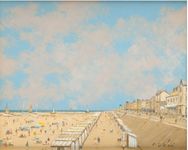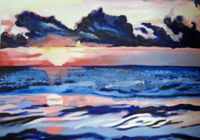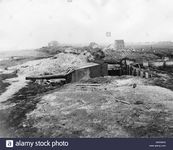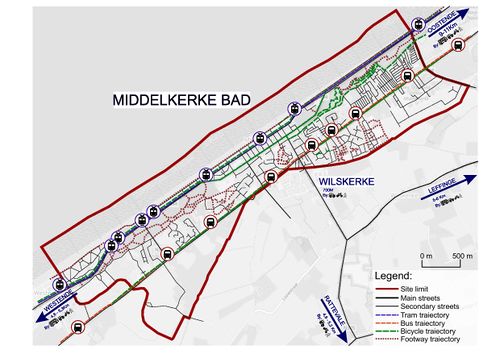COLAND Case Study 2020 - Middelkerke, Team Ion Mincu
>>>back to working groups overview
Rationale
- Why do you think this case is relevant? What is your hypothesis considering the landscape challenges?
This case is relevant because it is a seasonal tourist attraction and it has three strongly distinctive landscape patterns- semi-natural wide coastline, and artificial urban and agricultural patterns, which are affected because of people. Artificiality and existence of man brings out challenges in biodiversity, soils, water, and marine environment. The coast is most sensitive to floods, erosion, and eutrophication.
Location and scope
You can edit this map with the map editor
A Landscape System Analysis
A.1 Landscape layers and their system context
Geomorphology, landscape units and coastal typology
- The terrain forming the coat of Belgium dates back from the Holocene epoch (1.7 thousand years ago) from the Quaternary era. Due to the old age of the geological foundation and the proximity to the North Sea, most of the terrain is now underwater.
This problem was handled by the Belgium state by creating new arificial areas.
Land use
- settlements, infrastructure, agriculture, resource extraction, natural areas, energy production...
- description of evolution, status quo and driving forces, is the land use likely to change? Why is that? (approx 200 signs)
- add 1-2 graphical representations to the image gallery, you can add more if you like
Green/blue infrastructure
- What are the major potential elements of a green/blue infrastructure network? Are these likely to change/disappear? Why is that?
- Green area
- Normandpark
- agricultural field
- Natural
- Blue area
- Vijver Normandpark
- North sea
- pond
One of the most dominant green/blue infrastructures at Middlekerke can be found along the coastline. The Middlekerke s beach line is the longest in Belgium. It contains sand beaches. Residents and tourists can experience nature in this way. There are a Hiking trail from Middelkerke-Westende and Statues of cartoon characters and Cinema on the beach. It may affect the infrastructures of this green and blue and it might damage the nature. Tides and storms can affect also. Normandpark is A green infrastructure in the center of Middelkerke. It is located near the beach. The pond of Normandpark was redone in a sustainable way. This area is really comfortable for enjoying the nature in the center of Middlekerke.In addition, there are lots of agricultural fields that can be considered as green infrastructure.Most of the agricultural field in Belgium is divided between barley, corn, wheat, potatoes, and vegetables and fruits and there are some areas for breeding animals.
Actors and stakeholders
- The main actors are the Middelkerke Municipality and the West Flanders Authorities, but also the bussiness owners, the investors, the community and tourist. Each of these aactors and stakeholders have a higher or lower impact on the changes that affect Middelkerke and a higher or lower interest in what happens to the city.
- Draw a stakeholder and/or power map: Who is affected highly but with low power? Who has high power but is not affected?
Sacred spaces and heritage
- Which places/elements hold cultural value and to whom?
Built environment
Middelkerke is rich by its architectural heritage. Beautiful street views have characterized the town from the 19th century. Although the town has modernized you can see the hints of the city's historic architectural value through the Townhall, Traction station, Saint Theresa Chapel and through hotels, villas and even garage. The second most important value of the place is the train connection between Knokke and De Panne. That's the reason why seaside tourism in the area has been popular since World War I. These values are important to the citizens and tourists by its beauty and formed network.
Middelkerke Town Hall in Spermaliestraat 1. Protected building since June of 2002 in the Middelkerke Submunicipality. The eclectic Town Hall was built in 1924-1925 and is designed by architect G. Van Damme. [1]
The Coast Tram, the longest tram line in the world, is a public transport service between Knokke and De Panne [2]. In Middelkerke there are two architectural heritage buildings in Leopldlaan street honoring the original tramline- the Tram booth [3] and Traction station. The Traction station (on the picture) is built in the early 1920s and is designed by architect Georges Vivenoy. On the facade, there can be seen an art deco impact. Traction station has been protected as a monument since October of 1995.[4]
Art Nouveau style chapel of Saint Theresa is a protected building since June of 2002. The modernist north-south oriented chapel was founded in 1932-1933 and is designed by architect AV Flaubert. In the interior, there are numerous neoclassical elements, frescos and stained glass windows making the chapel an important sight to see. [5][6]
Middelkerke is rich by its architectural heritage. There are numerous protected buildings in the style of art deco and eclectic, built in the 1920s. On the picture is an example of eclectic Hotel Continental on the Joseph Casselaan 3, Zeedijk 59. It is situated in the promenade and has a view to the sea from Zeedijk street [7]. Few of them are the style of neo-gothic and neo-Rococo, which are built around 1889-1899. [8]
Natural environment
In Middelkerke there are three most important nature reserves- Warandeduinen, Puidebroeken, and Raversyde nature park. If Puidebroeken is important for birds, frogs, insects, and plants then Warandeduinen and Raversyde hold extra value for people's health and to the environment.
The Warandeduinen nature park is a certified nature reserve since 2003. The area size is 33 hectares big. [9]. This is a calcareous dune belt with a large and varied natural richness between Westende-Bad and Middelkerke. The area is rich by the growth of orchids [10]. Watch more photos in link: [11].
The Puidebroeken (in English: Puffy Trousers) is a 14.5 hectares big nature reserve near Middelkerke. It is a protected area since 2003. [12]. The area contains mainly artificial grounds from World War I when it was used to excavate clay for the production of brick. For now it a wet meadow that has a bad water runoff. There are living numerous meadow birds, frogs, insects, and plants. The area is not freely accessible. [13]
Raversyde Nature Park is a large landscape of water, reed fields, grasslands, meadows, plantations, and forests. It is situated in Ostend but is close to our case study Middelkerke. [14]
Artefacts
In between the coast of Middelkerke to Westende-Bad there are 15 bronze statues of cartoon characters and also five Beaufort monuments such as two horns (I Can Hear It) and excavator (Caterpillar 5bis), etc. These sculptures add symbolic meaning to Middelkerke's coast and town, and invites visitors to see them.
Visual appearance and landscape narrative
- Which elements are essential for the landscape character?
In Middelkerke, the coast and the sea play a central role. It contains sand beaches of about nine kilometers long which are connected by a boulevard and have characteristic features with its urban area and agricultural land behind. [17] [18]
- Has the landscape been painted or otherwise depicted, when and whom? Which elements are essential?
Many painters illustrated the interesting coastal landscape the colorful sea, and the nice urban view. Pierre Stefani (France, born 1938) depicted where people are enjoying in the summertime and where beach shows low sea tide. Claude Hardenne (France- 1946) depicted the colorful sea at the age of 16. [19][20]
- Which narratives exist? Who has written about this landscape or depicted it in some way?
The story of Middelkerke: Middelkerke seaside town equipped with Hotels, apartments, villas, cafes, restaurants, and beaches, as well as situated in dunes and polders. The polders perfectly suit for walks or bike and skeeters tour through an overwhelming landscape. Beach facilities and public facilities like tram are also located within the coastal area. [21] The first reference of Middelkerke is found in 1218. Before 1867 it mainly was farming settlements. One of the first world images of this area can be found on the map of the first world war by the war office and also a picture that shows the first world war in 1914 to 1918 that is taken by Chronicle. [22]
Whether to see the street view about 100 years ago and now you can see how drastically the image of the city has changed. Diverse architecture has been changed to a modern gray cubic wall, where nothing distinct.
A.2 Summary of your landscape system analysis and your development targets
- Link back to the Sustainable Development Goals: Which goals are at risk?
Goal 3: Good Health and Well-Being; Good health and well-being are always important for inhabitants. Because of the population growth and tourism, it is necessary to keep under control the social wealth and economy, to deal with an aging society and keep it in balance with modern worldviews. Also, more free tourism could bring problems to deal with, like diseases, cultural and safety issues, etc.
Goal 11: Sustainable Cities and Communities (Bike, walk or use public transportation); Although in Middelkerke there is a good pedestrian, bike and public transportation network near the coast it is important to keep them maintained and deal with infrastructure consciously taking in consideration that in Middelkerke the season lasts only 2-3 months.
Goal 12: Responsible Consumption and Production (recycled paper, plastic, glass, and aluminum); Due to the season lasts only 2-3 months in a year it is good to have sustainable waste development in the season and off the season. Production of single-use waste and overproduction are the things to work with.
Goal 13: Climate action; Cause the Climate Change and Global Warming is a well-known issue in all over the world, it affects also Belgium. It has to been taken into consideration that the coastal area and the town probably will be affected by floods, strong storms and winds and other changes in climate. The seasons could also be changing every year, longer autumn and spring and shorter summer and winter, etc.
Goal 14: Life Below Water; Because of agricultural chemicals, the state of water bodies is affected. Strong rains could cause eutrophication in ditches and rivers and that causes water quality to fall in connected waterbodies.
Goal 15: Life on Land; Because of the dense urban and agricultural area, the diversity of ecology is at risk. It is important to support existing biodiversity and create opportunities with greeneries to increase it.
- What is your hypothesis for this landscape?
Middelkerke is a dynamic town because of tourism. Tourism growth will affect the ecosystem because more tourism means more facilities and capacity for tourism attractions. To ensure the capacity the town needs more energy for production. More production increases the artificiality in the coast and agricultural land, and creating new and modern will lose the importance of history.
- Visualise your hypothesis with one graphic/pict
- Are there any existing initiatives taking action in this landscape? Do you have a critical perspective on that?
In the Middelkerke case is that they are not interested in keeping the nature and heritage of attraction for people. Instead, they want to keep their economy with seasonal events like Comic festival, market, and occasional music festivals. It causes seasonal overproduction and pollution which will change the environment and culture.
A.3 Theory reflection
- Reflect on at least three international policy documents in relation to their local landscape case
- choose one international, one European and one national document
- You can choose references from our reading list
- Scope: 250 words
A.4 References
Sacred spaces and heritage
Agency for Heritage Heritage 2020: Town hall of Middelkerke [online] https://id.erfgoed.net/erfgoedobjects/55041 (19-02-2020)
T.T.O.-Noordzee vzw [online] http://promottonoordzee.wixsite.com/mysite/copy-of-homepage-frans (19-02-2020)
Agency for Heritage Heritage 2020: Tramway [online] https://id.erfgoed.net/erfgoedobjects/55012 (19-02-2020)
Agency for Heritage Heritage 2020: Traction Station [online] https://id.erfgoed.net/erfgoedobjects/55010 (19-02-2020)
Agency for Cultural Heritage 2020: Sint-Theresiakapel [online] https://id.erfgoed.net/erfgoedobjects/54979 (19-02-2020)
Openchurches: Sint-Theresia [online] https://openchurches.eu/en/churches/sint-theresia-middelkerke (19-02-2020)
Agency for Heritage Heritage 2020: Hotel Continental [online] https://id.erfgoed.net/erfgoedobwerpen/55054 (02-02-2020)
Agency for Heritage Heritage 2020: Heritage objects in Middlekerke [online] https://inventaris.onroerenderfgoed.be/erfgoedobjecten?deelgemeente=35011A&pagina=1&gemeente=220 (02-02-2020)
Middelkerke, family seaside resort [online] https://middelkerke.org/en/middelkerke.php (19-02-2020)
Artistic spots in Middelkerke [online] https://www.belgiancoast.co.uk/en/artistic-spots-middelkerke-westende (19-02-2020)
First World War map of Ostende [online] http://www.bl.uk/onlinegallery/onlineex/maps/europe/ww1/4801909.html (19-02-2020)
Middelkerke, la digue et la plage à marée basse [online] http://www.artnet.com/artists/pierre-stefani/middelkerke-la-digue-et-la-plage-%C3%A0-mar%C3%A9e-basse-5rjMrWUXAqr14-w8PXyu4A2 (19-02-2020)
Claude Hardenne - "T'as voulu voir Honfleur" [online] https://artenligne-littlevangogh.com/Middelkerke?fbclid=IwAR3i32N_9fOL4wKv5J-1vABIJ9njRfnkSZR3XImP4tlWq-CgYqOKcMdk_1M (19-02-2020)
Phase B: Landscape Evaluation and Assessment
B.1 Assessment Strategy
- Based on the hypothesis derived from your previous landscape systems analysis you are now asked to define the goals for assessing the landscape. Your assessment is the basis for evaluating the landscape status.
- Which elements and phenomena need to be mapped, why and how?
- This a text contribution, max 250 words
B.2 Mapping
Tourism
The number of the tourists as well as the activities available are influenced by the weather and therefore by the changing of seasons. The most significant numbers of tourists, over 200 000, happen in summer, followed by spring with a number of approximately 150 000 tourists, when most outdoor activities become available. The number of the festivals is also one of the factors that lead to a higher number of tourist in summer. Taking for example the events planned for Middlekerke in 2019 we have 8 festivals in spring, 21 in summer , 3 in Autumn and 4 in Winter. Outdoor activities in Middlekerke include cycling and hiking, water sports and swimming, festivals, horse ridding and golf. The distribution of tourist accommodation along with Restaurants and Bars is uneven. Towards the coast there is a cluster of activities, whilst further into the city there are little to none. Although the activity zones are compact the diversity is not lacking. There are restaurants for any budgets, aimed mostly towards the middle class. Regarding the accommodation, there are a few options to chose from, but most of them belonging to the hostel and bed and breakfast category
Connectivity
Buildings and activities
The activities in the area area heavily dependent on tourism and agriculture with most commercial activities happening at the sea shore. There are only 3 schools in the area and no hospital. The closest hospital is located at 3 km outside od the city, in the north east. There is another one located in the nord-West of the city at approximately 5 km from the city. Despite the long distance between these endowments, the public transportation offers an easy solution for them to become reachable.
B.3 Problem definition and priority setting
- Give a summary of the major findings of your mapping process, what are the problems/potentials identified?
- Draw a problems/potentials map
- Set priorities for the most relevant issues
B.4 Theory reflection
- Please reflect the assessment and evaluation methods used based on at least three readings
- Did you encounter limitations'
- 200 words test contribution
B.5 References
- give a full list of the references you have used for this section
Phase C – Strategy and Master Plan
C.1 Goal Setting
- Define strategic planning objectives based on the evaluation findings
- Link back to your original targets from section one and the Development Goals
- 150 words text contribution
C.2 Spatial Strategy and Transect
- translate your strategic goals into a vision
- develop a spatial translation of your vision
- exemplify your vision in the form of a transect with concrete interventions
- add map(s) and visualizations
- Your case spatial translaton vision.jpg
add caption here
- Your case transect.jpg
add caption here
- Your case transect detail1.jpg
add caption here
- Your case transect detail2.jpg
add caption here
C.3 From Theory of Change to Implementation
- For implementing your vision: Which partnerships are needed? Which governance model is required?
- Who needs to act and how? Draw and explain a change/process model/timeline
- Which resources are needed? On which assets can you build?
- add 150 words text and visuals
- Your case spatial your governance model.jpg
add caption here
- Your case spatial your process model.jpg
add caption here
C.4 References
- give a full list of the references you have used for this section
D. Process Reflection
- Reflect in your intercultural and interdisciplinary team on the outcomes of your study
- Which limitations were you facing?
- What have you learnt from each other?
- What would you do differently next time?
- You can also use diagrams/visuals
- 250 words text




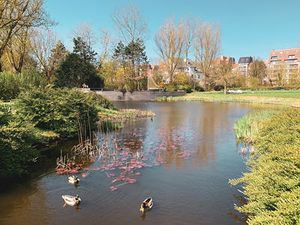



![Middelkerke Town Hall in Spermaliestraat 1. Protected building since June of 2002 in the Middelkerke Submunicipality. The eclectic Town Hall was built in 1924-1925 and is designed by architect G. Van Damme. [1]](/images/thumb/c/c9/Middelkerke_town_hall.png/195px-Middelkerke_town_hall.png)
![The Coast Tram, the longest tram line in the world, is a public transport service between Knokke and De Panne [2]. In Middelkerke there are two architectural heritage buildings in Leopldlaan street honoring the original tramline- the Tram booth [3] and Traction station. The Traction station (on the picture) is built in the early 1920s and is designed by architect Georges Vivenoy. On the facade, there can be seen an art deco impact. Traction station has been protected as a monument since October of 1995.[4]](/images/thumb/2/25/Traction_station.png/200px-Traction_station.png)
![Art Nouveau style chapel of Saint Theresa is a protected building since June of 2002. The modernist north-south oriented chapel was founded in 1932-1933 and is designed by architect AV Flaubert. In the interior, there are numerous neoclassical elements, frescos and stained glass windows making the chapel an important sight to see. [5][6]](/images/thumb/c/c5/Saint_Theresa_Chapel.png/200px-Saint_Theresa_Chapel.png)
![Middelkerke is rich by its architectural heritage. There are numerous protected buildings in the style of art deco and eclectic, built in the 1920s. On the picture is an example of eclectic Hotel Continental on the Joseph Casselaan 3, Zeedijk 59. It is situated in the promenade and has a view to the sea from Zeedijk street [7]. Few of them are the style of neo-gothic and neo-Rococo, which are built around 1889-1899. [8]](/images/thumb/3/37/Architecture.png/84px-Architecture.png)

![The Warandeduinen nature park is a certified nature reserve since 2003. The area size is 33 hectares big. [9]. This is a calcareous dune belt with a large and varied natural richness between Westende-Bad and Middelkerke. The area is rich by the growth of orchids [10]. Watch more photos in link: [11].](/images/thumb/b/b8/De_warandeduinen.jpg/200px-De_warandeduinen.jpg)
![The Puidebroeken (in English: Puffy Trousers) is a 14.5 hectares big nature reserve near Middelkerke. It is a protected area since 2003. [12]. The area contains mainly artificial grounds from World War I when it was used to excavate clay for the production of brick. For now it a wet meadow that has a bad water runoff. There are living numerous meadow birds, frogs, insects, and plants. The area is not freely accessible. [13]](/images/thumb/2/2a/Puffy_trousers.jpg/200px-Puffy_trousers.jpg)
![Raversyde Nature Park is a large landscape of water, reed fields, grasslands, meadows, plantations, and forests. It is situated in Ostend but is close to our case study Middelkerke. [14]](/images/thumb/f/fb/Raversyde_nature_park.jpg/200px-Raversyde_nature_park.jpg)
![Comic art in Middelkerke [15]](/images/thumb/0/09/Statues_of_cartoon_characters.jpg/169px-Statues_of_cartoon_characters.jpg)
![I can hear it by Ivars Drulle. Beaufort gems in Middelkerke.[16]](/images/thumb/2/25/I_can_hear_it.jpg/200px-I_can_hear_it.jpg)
